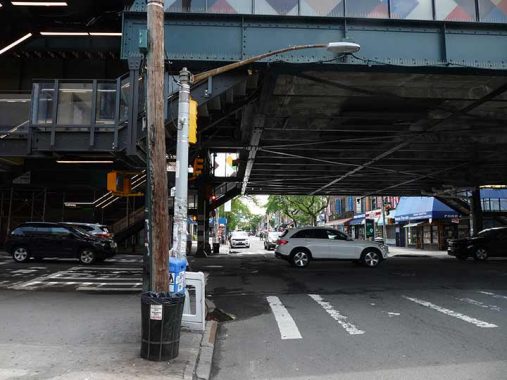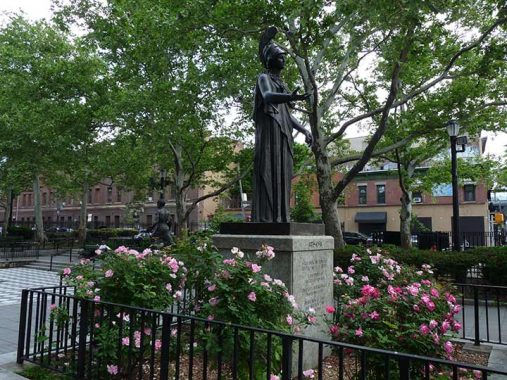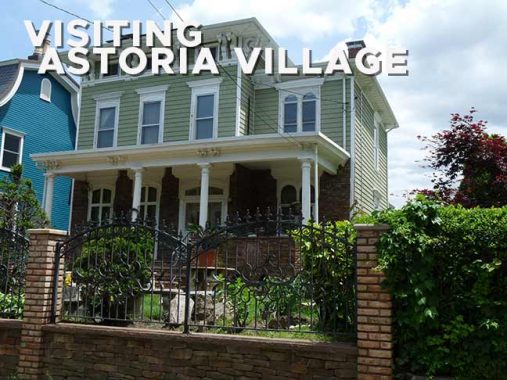
PERIODICALLY I visit Astoria Village to see how it is getting along. I first saw the neighborhood in 1998 at the dawn of the Forgotten New York Era, when there was more of it. Though its streets were once populated with dozens of jewel box Victorian-era houses arrayed along 12th and 14th Streets and 27th Avenue south of Astoria Park for the most part, short sightedness on behalf of local politicians and the Landmarks Preservation Commission have failed to save most of them. As older residents move out, newer arrivals found the buildings, as attractive as they are, insufficient for their needs both in space and with things like electrical wiring and other necessities, and down the houses have come, to be replaced by much blander construction from the late 20th and early 21st Centuries. It is a never ending struggle between the values of the past and present.
Astoria Village is a small part of the larger neighborhood named Astoria and is located west of 21st Street, north of Astoria Boulevard and south of Astoria Park. Its pedigree dates to the mid-1600s, when William Hallett received a grant for the area surrounding what is now Hallett’s Cove by Peter Stuyvesant. However, the oldest structures in the region date to the mid-1800s, after fur merchant Stephen Ailing Halsey had incorporated the village in 1839. It was named for a man who apparently never set foot in it. A bitter battle for naming the village was finally won by supporters and friends of John Jacob Astor (1763-1848). Astor, entrepreneur and real estate tycoon, had become the wealthiest man in America by 1840 with a net worth of over $40 million. (As it turns out, Astor did live in “Astoria”–his summer home, built on what is now East 87th Street near York Avenue–from which he could see the new Long Island Village named for him.) Halsey was trying to induce Astor to invest in a local seminary, but Astor donated just $500.
Wealthy businessmen built homes on what are now 12th and 14th Street, some cozy boxes, others large, ornate mansions; sadly, most of those that remain have been altered nearly beyond recognizability.
Astoria Boulevard was first developed by Halsey as a connection to Flushing from the local ferry at Hallett’s Cove. The Hallett’s Cove and Flushing Turnpike first opened in 1835 and for many years, into the 20th Century, it was called Flushing Avenue.

To reach Astoria Village, I detrained from the BMT Astoria Line at 30th Avenue and walked west. I found this “dwarf” lamppost under the el interesting. 30th Avenue was once known as Grand Avenue, a main route in and out of Long Island City.
Athens Square
Immediately you are met with a reminder of Astoria’s 20th Century status as a haven for Greek immigrants, at Athens Square at 30th Avenue and 30th Street.

Anthony Frudakis‘ bronze of the philosopher Socrates was unveiled in 1993, while three adjacent granite Doric columns arrived in 1996. In 1998, Athens mayor Demetris Avramopoulos presented the city with a replica of the Piraeus Athena (originally sculpted about 350 BC). It depicts the ancient Greek goddess of wisdom and patroness of the arts. The Aristotle bust was sculpted by George V. Tsaras of Greece and is a gift from the people of Halkidiki, a peninsula in the Greek region of Macedonia; it was unveiled in April 2008. [NYC Parks]
Though the casual observer thinks of Astoria as primarily a Greek enclave, the neighborhood’s Greek population has decreased in recent years — not in a mass exodus, but it has been lessening. To repeat a cliché, Astoria is one of the City’s truest ‘melting pots’ with Greeks, other Eastern European nationalities such as Albanians, Bulgarians, and Bosnians, Jews, Brazilians, Maltese, Spanish and Bangladeshis all sharing the stage with run of the mill Irish, like me.
This Hellenic-American Neighborhood Action Committee Building is still recognizable as a Romanesque police precinct built around 1890. Note the two police badges sculpted under two top floor windows, along with interesting terra cotta that may have come from the New York Architectural Terra Cotta Works on Vernon Boulevard south of the Queensboro Bridge.
In Astoria and elsewhere, clues of streets’ former names can be found on buildings, whether chiseled street signs or, in this case, apartment house names. Grand Court and Ely Court testify to 30th Avenue’s old name, Grand Avenue, and 23rd Street’s former name, Ely Avenue.
And a couple of blocks away on 30th Avenue, we have the Van Alst Playground, which echoes 21st Street’s former name Van Alst Avenue, also name checked in the 21st-Van Alst G train station a couple of miles south of here.
Welling Court
L-shaped Welling Court runs from Main Avenue south and east to 12th Street. Welling and Main Avenue alone follow Astoria Village’s original 17th-Century street plan, as well as the zigzagging 12th Street.
Main Avenue and Welling Court define the outline of the Hallet vegetable garden. The Hallet barn was at the end of Welling Court. About 1837, the ancient Hallet farm was cut up into lots. The property was divided into 100/200 ft plots that sold for $150 each. Welling Court has survived the ages, for over 300 years.
For the past decade the buildings on Welling Court have been livened by colorful and engaging installations from local street artists. In 2022, I found the latest entries less spectacular than usual, but it’s a matter of taste.
The Reformed Dutch Church of Astoria (now sharing space with a Spanish Protestant church) at 27-26 12th Street was built in 1888; its verdigris’ed copper steeple replaced the original in 1900. The parsonage, which may date as early as the 1850s, is just to its south. The three rings in the stained glass window, which resembles the old Ballantine Beer logo, simply represents the Christian belief of Holy Trinity, Father, Son and Holy Spirit. All are God, but in three separate Persons.
Astoria Village
Hallett’s Cove today, the region in Astoria just south of Astoria Park and west of 21st Street, is today a mixture of breathtaking houses, ancient churches and graveyards, as well as forbidding, utilitarian housing projects and industrial buildings. The area near Astoria Park, as well as Ditmars to the north, feature views of the Hell Gate (1910) and Triborough (1936) bridges. It’s typical of the resolute nondevelopment of New York City’s waterfront that the closer to the water you get, the more boring the housing gets.
The Chamberlain-Taylor (deWayt) house, 9-29 27th Avenue at 12th Street, goes all the way back to 1845. Note the eyebrow windows below the roofline.
Now a Greek Orthodox church, the Robert Blackwell house was constructed at the NE corner of 12th Street and 27th Avenue in the 1840s. The Blackwell family left is mark on western Long Island and on the island now known as Roosevelt Island.
Native Americans called the island Minnehanak (“a great place to live”), but it has gone under a variety of names in English. The Dutch called it Varkens, or Hog Island. Its first permanent resident was Captain John Manning, a disgraced British naval officer who allowed Fort Amsterdam (on Governor’s Island) to fall to the Dutch in 1673.
Upon Manning’s death the island was passed on to his stepdaughter Mary and her husband, Robert Blackwell, and the island stayed in the Blackwell family till 1823, retaining the name “Blackwell’s Island” for years after that.
Blackwell’s Island became Welfare Island in 1921, and finally, since 1973, Roosevelt Island; a substantial memorial to Franklin Delano Roosevelt was supposed to occupy the island’s southern tip, but the plans were delayedwhen architect Louis Kahn passed away. The memorial was finally dedicated in Four Freedoms Park on the island’s southern edge in 2012.
The oldest building on Roosevelt Island is the Blackwell Farmhouse which dates to 1796.
More of the ingenious, attractive private homes on 12th Street in Astoria Village. Some are two-family, some are modest, some are double houses of a type little seen in NYC. Unfortunately I do not have a Landmarks Preservation guide for the area since the LPC has never designated it, so digging into the histories of these buildings would call for hours in a library basement somewhere.
One of the largest of the classic Astoria Village homes is a porched mansion at 26-07 12th Street, which has is own private terrace and sculpture garden.
The massive Shore Towers, #25-40 12th Street, was constructed in the 1980s and towers over everything else in Astoria Village. It does provide public waterfront access with a no-frills walkway that faces Pot Cove, an indentation in the East River shoreline.
Shore Boulevard begins at Astoria Park South and 12th Street and runs along the East River and the park. A couple of years ago, it was closed to automobile traffic for most of its length in favor of bicyclists, runners and pedestrians.
Rosemont
What was once known as Rosemont, a mansion on 25-37 14th Street, has been pretty much buried by now under aluminum siding, but it used to be a beautiful two-level Doric-columned country house.
In 1852 the mansion was built in a grand Southern-plantation style by varnish moguls Smith & Stratton, who operated in Astoria Village till 1856; they then decamped further down the east Riverside to Hunter’s Point. In the 1990s, it was converted to the wreck you see today at 25-37 14th Street, “raped and ravaged” in the words of the AIA Guide to NYC. Its ancient copper beech tree has long been chopped down, and the exterior has been converted to something considered more appropriate to the times by its current owner, or at least a recent one. (I don’t know the derivation of the current name, “Bilquis Mansion.”)
“The Benner Mansion, occupied for many years by the late Robert Benner, a prominent New York lawyer, is another superb place. Mr. Benner was an enthusiast in floriculture and arboriculture. The beautiful gardens contain many specimens of rare trees and shrubs while the flower beds, chrysanthemums and rose houses have wide renown. The cultivation of these flowers was Mr. Benner’s delight and he added many new specimens by propagation and cultivation to the world’s knowledge. He named his house “Rosemont!” and the name was appropriate. Mrs. Benner resides in the old home, and as her love for flowers equals that of her late husband, the place is still superbly kept up. Mr. Benner’s sons, Willis and Charles, are the law firm of Benner & Benner of Wall St. They both live in Astoria, the former in the old homestead and Charles in the former house of the late Joshua Lathrop, the old New York flour merchant.” – New York Times, July 12, 1896
On occasion larger homes on wider plots can be found in Astoria Village, such as the former Trowbridge mansion at 26th Avenue and 14th Street. The Trowbridges owned a number of houses in Astoria Village in the 1800s. I wonder if the plastic bovines on the lawn are from either of NYC’s two Cow Parades.
This house with charming woodwork at 26-29 14th Street has an empty lot next to it…
…that belonged to this jewel box house with equally charming woodwork next door, until it was torn down.
What will replace it? Something like this, #26-35 14th Street, which is what modern builders are looking for in residential architecture.
St. George’s
In many ways the stately brick edifice, St. George Episcopal Church, is the centerpiece of Astoria Village. There has been a St. George Episcopal parish in Astoria since 1825 when its site was donated by landowner Robert Blackwell; its original church was on Franklin Street, today’s Astoria Boulevard. After that edifice burned down in 1894, the present brick church at 27th Avenue and 14th Street was raised in 1903-1904.
St. George’s isn’t the only item of interest here. Before the 20th Century, churches of all denominations maintained cemeteries for their congregants on their grounds. If you know where to look, St. George’s churchyard is still there, but you need to walk up a driveway and peer over a fence alongside a dumpster to see it. The historic cemetery contains remains of early settlers in the area, the Blackwells and Trowbridges. It used to be attainable from 14th Street, but after a senior center was built alongside St. George’s, the decision was made to make the entrance more hidden. Until recently I was able to enter the churchyard but the gate is kept locked now, and I didn’t want to risk trouble by climbing over it.
Astoria Village’s handsome library building at Astoria Blvd. and 14th Street occupies the spot of the original St. George’s Church. It was constructed after a generous grant from industrialist/philanthropist Andrew Carnegie and was finished by 1904. Carnegie’s largesse allowed 1,689 libraries to be built across the USA. Dozens of Carnegie libraries still stand in NYC.
Batch: 141 photos
Date: May 29, 2022
My walk wasn’t done: I skirted Astoria Park under the Triboro and Hell Gate bridges, then moved east through Ditmars and then reversed course to catch the N train, but that will be for another post.
As always, “comment…as you see fit.” I earn a small payment when you click on any ad on the site.
7/17/22
